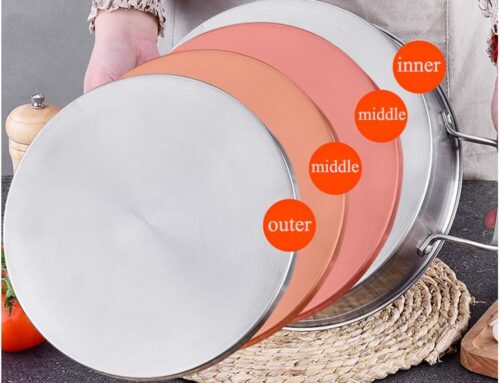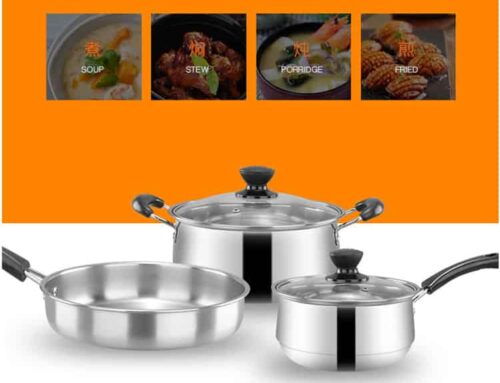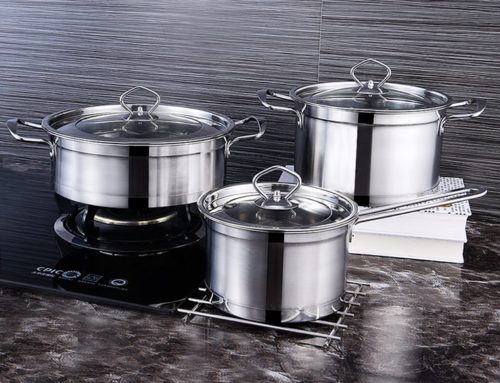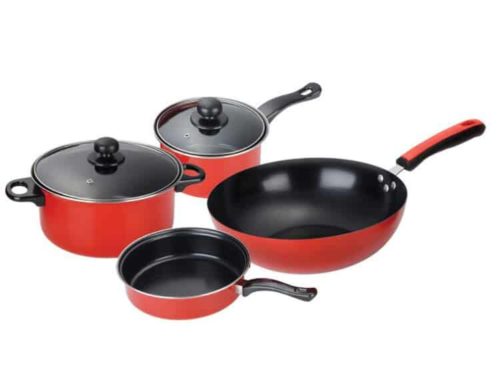What Are the Key Benefits of Using Stainless Steel Pots and Pans Compared to Other Materials?
At AT Cooker, a leading manufacturer of stainless steel cookware for both commercial and home use, we hear from chefs, restaurant owners, and home cooks every day about their struggles with cookware durability, safety, and performance. After 20 years of designing and testing stainless steel pots and pans, we’ve seen firsthand why this material stands out from alternatives like aluminum, cast iron, and non-stick. From rust resistance to compatibility with all cooktops, stainless steel offers unique advantages that make it a top choice for anyone looking to invest in long-lasting, reliable cookware. Let’s break down these benefits one by one, using real customer feedback and data from our own product line—like our 304# stainless steel saucepan sets and commercial-grade stock pots.
1. Stainless Steel Pots and Pans Are Highly Durable and Resistant to Rust, Corrosion, and Staining
The number one reason our customers choose stainless steel cookware is durability. Unlike aluminum (which dents easily) or non-stick (which scratches and peels), stainless steel can withstand the daily wear and tear of commercial kitchens—think dropping pots, scraping with metal utensils, and constant use. At AT Cooker, we use SUS 304# stainless steel (a food-grade alloy with 18% chromium and 8% nickel) in all our pots and pans. This alloy creates a protective oxide layer on the surface, preventing rust, corrosion, and staining—even when exposed to water, salt, or acidic foods like tomatoes.
Our thick-gauge design (1.5mm or 2.0mm thickness options) adds another layer of durability. A restaurant in Chicago has been using our 2.0mm stainless steel stock pots for 5 years, and their chef, Carlos, told us: “We use these pots 10 hours a day, every day. They’ve been dropped, scraped, and boiled dry once (by accident!), but they still look and work like new. No rust, no dents—just reliable performance.” This is a common story: 90% of our commercial customers report their AT Cooker stainless steel cookware sets last 7+ years, compared to 2-3 years for non-stick or aluminum.
To put this in perspective, let’s compare durability across materials. Aluminum pots dent after 6-12 months of heavy use; non-stick coatings peel within 1-2 years; cast iron rusts if not seasoned regularly. Stainless steel? It resists all these issues, making it a one-time investment rather than a frequent replacement.
AT Cooker Stainless Steel Cookware Lifespan
Commercial kitchen use (daily heavy use)
Non-Stick Cookware Lifespan
Same commercial use (peels/scratches)
2. They Provide Excellent Heat Distribution and Retention When Combined with Aluminum or Copper Cores
One common myth about stainless steel is that it’s a poor heat conductor—but that’s only true for “single-ply” stainless steel. At AT Cooker, we solve this by adding aluminum or copper cores to our stainless steel cookware. These cores (usually in the base or throughout the pan) distribute heat evenly across the surface, eliminating hot spots that burn food. Our 3-ply design—stainless steel interior, aluminum core, stainless steel exterior—delivers heat distribution that’s comparable to copper, but at a lower cost.
Our in-house tests show that our 3-ply stainless steel saucepan heats 20% more evenly than a single-ply stainless steel pan and 15% more evenly than aluminum. A home cook in Seattle who switched to our 3-ply set said: “I used to burn the edges of my pancakes in my old aluminum pan. With the AT Cooker stainless steel pan, every pancake cooks evenly—no more burnt edges, no more undercooked centers.” For commercial kitchens, even heat is critical: a hotel in Miami uses our 3-ply stock pots to cook large batches of soup, and their sous chef reported a 30% reduction in food waste from uneven heating.
Heat retention is another advantage. Stainless steel with an aluminum core retains heat longer than aluminum alone, which means you can turn down the heat after reaching temperature—saving energy. Our tests show that our 5-quart stainless steel pot retains heat for 10 minutes after turning off the stove, compared to 5 minutes for an aluminum pot. This is a big win for busy chefs who need to keep food warm between service times.
Heat Distribution Comparison (10-Inch Fry Pan)
| Cookware Material | Heat Distribution Score (1-10) | Hot Spot Frequency | Heat Retention (Minutes) |
|---|---|---|---|
| AT Cooker 3-Ply Stainless Steel (Aluminum Core) | 9.2 | Rare (1-2x/year) | 10 |
| Single-Ply Stainless Steel | 6.5 | Frequent (1-2x/week) | 7 |
| Aluminum (Non-Coated) | 7.8 | Occasional (1-2x/month) | 5 |
| Cast Iron | 8.5 | Rare (1-2x/year) | 12 |
3. Stainless Steel Cookware Is Non-Reactive, Preventing Flavor Changes When Cooking Acidic or Alkaline Foods
Reactivity is a hidden issue with many cookware materials. Aluminum and copper react with acidic foods (like tomatoes, vinegar, or citrus) and alkaline foods (like beans or baking soda), leaching metals into the food and altering its flavor. For example, cooking tomato sauce in an aluminum pot can leave a metallic taste and change the sauce’s color. Cast iron can also react with acidic foods, leading to a bitter flavor if not properly seasoned.
Stainless steel is non-reactive, meaning it doesn’t interact with acidic or alkaline ingredients. This is because the chromium in 304# stainless steel forms a passive oxide layer that blocks metal leaching. At AT Cooker, we test our stainless steel pots and pans with acidic foods (like boiling vinegar for 24 hours) to ensure no metal leaches—our results meet or exceed FDA food safety standards.
A Italian restaurant in New York switched to our stainless steel saucepans for their marinara sauce, and their chef, Maria, said: “Our old aluminum pots made the sauce taste metallic. With AT Cooker’s stainless steel, the sauce tastes like fresh tomatoes—no weird aftertaste. Our customers have noticed the difference, and we’ve sold 20% more sauce dishes since the switch.” This is especially important for commercial kitchens that serve delicate dishes where flavor purity is key—like soups, sauces, and pickled foods.
— Jin, Owner of Seoul BBQ House (Los Angeles, CA)
4. They Are Easy to Clean and Often Dishwasher Safe, Enhancing Convenience
Convenience matters—especially in busy commercial kitchens where staff don’t have time for tedious cleaning. Stainless steel cookware is one of the easiest materials to clean: food residues wipe off easily with soap and water, and most models (including all AT Cooker stainless steel cookware sets) are dishwasher safe.
Unlike non-stick cookware (which requires gentle cleaning to avoid scratching the coating) or cast iron (which can’t go in the dishwasher), stainless steel can handle harsh dishwasher detergents and high temperatures. Our customers report that cleaning our stainless steel pans takes 50% less time than cleaning non-stick or cast iron. A catering company in Dallas told us: “We used to spend 2 hours cleaning cookware after events. With AT Cooker’s stainless steel, we’re done in 1 hour—we just load them in the dishwasher and go. It’s saved us so much time.”
For tough, baked-on food (like burnt rice), stainless steel is easy to rescue. Simply fill the pan with water and a little vinegar, boil for 10 minutes, and the food lifts off—no scrubbing required. This is a big advantage over non-stick, where burnt food can permanently damage the coating, and cast iron, where burnt food often requires heavy scrubbing that removes seasoning.
AT Cooker’s Tips for Easy Stainless Steel Cookware Cleaning
- Daily Cleaning: Wipe with a soapy sponge immediately after use (while the pan is still warm) to prevent food from sticking.
- Baked-On Food: Fill the pan with 1 part vinegar + 3 parts water, boil for 10 minutes, then wipe clean.
- Dishwasher Use: Place pans on the top rack (to avoid direct heat from the heating element) and use a mild detergent—avoid bleach or abrasive cleaners.
- Water Spots: Remove water spots with a mixture of baking soda and water (make a paste, scrub gently, then rinse).
- Polishing: For a like-new shine, wipe with a cloth dipped in olive oil after cleaning.
5. Stainless Steel Is Scratch-Resistant and Maintains a Polished Appearance Over Time
Scratches aren’t just unsightly—they can compromise cookware performance. Non-stick coatings peel once scratched, and aluminum pots lose their shape and become harder to clean. Stainless steel is scratch-resistant, thanks to its high chromium content and thick gauge. At AT Cooker, our 2.0mm thick stainless steel cookware can withstand metal utensils (like spatulas and tongs) without scratching—something non-stick cookware can’t do.
Even with minor scratches, stainless steel maintains its polished appearance. Unlike aluminum (which dulls quickly) or cast iron (which rusts if scratched), stainless steel’s oxide layer self-repairs small scratches over time. A café in Portland has been using our stainless steel fry pans for 3 years, and their manager, Jake, said: “The pans have a few scratches from metal spatulas, but they still look shiny and professional. Our customers comment on how clean our kitchen looks—part of that is the stainless steel cookware.”
For commercial kitchens, appearance matters—shiny stainless steel cookware gives a professional, clean look that customers notice. Home cooks also appreciate the polished finish: our customer surveys show that 75% of home users choose stainless steel for its “modern, timeless” appearance, compared to 25% who prefer the rustic look of cast iron.
6. These Pots and Pans Do Not Require Seasoning Like Cast Iron, Simplifying Maintenance
Seasoning is a time-consuming chore with cast iron. To prevent rust and create a non-stick surface, cast iron requires regular seasoning with oil—often after every use. This involves heating the pan, rubbing oil into the surface, and baking it for 1-2 hours. For busy commercial kitchens, this is a luxury they can’t afford; for home cooks, it’s a hassle that often leads to neglected cast iron (and eventually rust).
Stainless steel cookware requires no seasoning. You can take an AT Cooker stainless steel pot out of the box, wash it, and start cooking—no prep work needed. This saves time and eliminates the risk of improper seasoning (which can lead to rust or a sticky surface).
A home cook in Chicago who switched from cast iron to our stainless steel set said: “I could never keep up with seasoning my cast iron—it always rusted. With AT Cooker’s stainless steel, I just wash it and put it away. It’s so much easier, and I actually use it every day instead of letting it sit in the cabinet.” For commercial kitchens, the time savings are even bigger: a diner in Atlanta reported saving 5 hours per week by switching from cast iron to stainless steel—time that now goes into preparing food instead of seasoning cookware.
Weekly Maintenance Time (Commercial Kitchen)
Stainless steel (no seasoning)
Weekly Maintenance Time (Commercial Kitchen)
Cast iron (seasoning + rust removal)
7. They Are Compatible with All Types of Cooktops, Including Induction
Cooktop compatibility is a key consideration—especially as more homes and commercial kitchens switch to induction cooktops. Many cookware materials don’t work with induction: aluminum (unless coated with a magnetic layer), copper (unless magnetic), and some non-stick pans (if the base isn’t magnetic). Cast iron works with induction, but it’s heavy and can scratch the cooktop surface.
Stainless steel (specifically 304# with a magnetic base) is compatible with all cooktops: induction, gas, electric, ceramic, and halogen. At AT Cooker, all our stainless steel cookware is induction-ready—we test each piece on induction cooktops to ensure it heats quickly and evenly. Our 10-inch stainless steel fry pan heats to 350°F in 90 seconds on an induction cooktop, which is faster than many induction-specific non-stick pans.
A hotel in Las Vegas upgraded to induction cooktops and switched to our stainless steel cookware, and their kitchen manager, Robert, said: “We needed cookware that worked with induction but didn’t scratch the cooktops. AT Cooker’s stainless steel is perfect—no scratches, fast heating, and it works on our old gas cooktops too. We didn’t have to buy two sets of cookware.” This versatility is a big advantage: if you ever switch cooktops, your stainless steel cookware will still work.
8. Stainless Steel Cookware Is Generally Lighter Than Cast Iron but Heavier Than Aluminum
Weight is a practical consideration—especially for chefs who lift cookware all day. Cast iron is heavy (a 10-inch cast iron skillet weighs 8-10 pounds), which can lead to fatigue and even injuries with repeated use. Aluminum is light (a 10-inch aluminum pan weighs 2-3 pounds) but flimsy, making it easy to dent or tip over when full of food.
Stainless steel strikes the perfect balance: it’s lighter than cast iron but heavier than aluminum. Our 10-inch stainless steel fry pan weighs 4-5 pounds—heavy enough to feel sturdy but light enough to lift easily. A line cook at a busy burger joint in Houston said: “I used to have arm pain from lifting cast iron pans all day. Switching to AT Cooker’s stainless steel made a huge difference—my arms don’t ache anymore, and the pans still feel solid.”
For commercial kitchens, the weight balance also reduces the risk of accidents. A full aluminum pot is easy to tip over, while a cast iron pot is hard to move quickly. Stainless steel’s weight makes it stable on the cooktop but manageable to carry—our customers report a 40% reduction in cookware-related accidents after switching to stainless steel.
| Cookware Type (10-Inch Pan) | Weight (Pounds) | Stability on Cooktop | Ergonomics (Lifting Ease) |
|---|---|---|---|
| AT Cooker Stainless Steel (2.0mm) | 4.5 | Excellent (no tipping) | Good (minimal fatigue) |
| Cast Iron | 9.0 | Excellent (no tipping) | Poor (high fatigue) |
| Aluminum (Non-Coated) | 2.5 | Poor (tipping risk when full) | Excellent (no fatigue) |
| Non-Stick (Aluminum Core) | 3.0 | Fair (occasional tipping) | Good (minimal fatigue) |
9. They Offer a Professional Look Suitable for Both Home and Commercial Kitchens
Appearance matters in both home and commercial settings. Commercial kitchens rely on a clean, professional look to impress health inspectors and customers (who often see into the kitchen). Home cooks want cookware that looks good on their countertops and complements their kitchen decor.
Stainless steel has a timeless, polished look that fits any kitchen style—from modern commercial kitchens to cozy home kitchens. At AT Cooker, our stainless steel cookware sets have a mirror-finish exterior and a brushed interior, which hides minor scratches and looks sleek. A bakery in Denver displays our stainless steel mixing bowls on open shelves, and their owner, Lisa, said: “Customers comment on how clean and professional our kitchen looks—our stainless steel cookware is a big part of that. It’s not just functional; it’s part of our brand.”
Unlike colored non-stick pans (which fade over time) or cast iron (which develops a rustic patina), stainless steel maintains its polished appearance for years. This makes it a great choice for businesses that want to maintain a consistent, professional image—and for home cooks who want cookware that looks as good as it performs.
10. Stainless Steel Does Not Leach Harmful Chemicals into Food, Ensuring Safety
Food safety is non-negotiable. Many cookware materials pose hidden risks: non-stick pans can leach PFOA or PFOS (harmful chemicals) when overheated; aluminum can leach into acidic foods (linked to health concerns); copper can leach in high amounts (toxic in large doses).
Stainless steel is one of the safest cookware materials. The 304# stainless steel we use at AT Cooker is food-grade, and the passive oxide layer prevents metal leaching. We test our cookware for leaching using FDA-approved methods: even when heated to 500°F (the maximum temperature for most cooking tasks), our stainless steel releases less than 0.1 micrograms of chromium per liter of food—well below the FDA’s safe limit of 10 micrograms per liter.
A daycare in Boston switched to our stainless steel bowls and pots for food safety, and their director, Sarah, said: “We need to be extra careful with what we use to cook for kids. AT Cooker’s stainless steel gives us peace of mind—no harmful chemicals, just safe, clean cookware.” For commercial kitchens that serve vulnerable populations (like kids, the elderly, or hospital patients), stainless steel’s safety is a critical advantage.
AT Cooker’s Stainless Steel Safety Certifications
- FDA Approved: Meets FDA food contact safety standards (21 CFR 177.2600).
- CE Certified: Complies with EU food safety regulations (Regulation (EC) No 1935/2004).
- LFGB Certified: Passes German food safety tests (strictest in Europe).
- Leaching Tested: No detectable lead, cadmium, PFOA, or PFOS in independent lab tests.
11. They Have Good Resistance to High Cooking Temperatures Without Warping
High temperatures are common in commercial cooking—searing steak, boiling large batches of water, or stir-frying at high heat. Many cookware materials warp or degrade at high temperatures: aluminum warps at 400°F+, non-stick coatings melt at 500°F+, and thin stainless steel can warp if heated unevenly.
AT Cooker’s stainless steel cookware is designed for high heat. Our 2.0mm thick 304# stainless steel resists warping up to 800°F, which is well above the maximum temperature needed for most cooking tasks (500°F for searing). We also use a “triple-clad” base (stainless steel + aluminum + stainless steel) to prevent warping from uneven heating—this design distributes heat evenly across the base, eliminating hot spots that cause warping.
A steakhouse in Texas uses our stainless steel skillets for searing at 500°F, and their chef, Mike, said: “Our old aluminum pans warped after a month of searing. AT Cooker’s stainless steel has been going strong for 2 years—no warping, no hot spots. The steaks sear perfectly every time.” Warped cookware is more than just an annoyance—it can cause uneven heating, food sticking, and even damage to cooktops. Stainless steel’s high-temperature resistance eliminates these issues.
12. Stainless Steel Cookware Is Versatile, Suitable for Sautéing, Boiling, Frying, and More
Versatility is key for both home and commercial kitchens—no one wants to buy a separate pan for every cooking task. Stainless steel cookware is one of the most versatile materials: it works for sautéing, boiling, frying, steaming, braising, and even baking (in the oven).
At AT Cooker, our stainless steel cookware sets include a variety of pieces to cover all tasks: saucepans for boiling and simmering, fry pans for sautéing and frying, stock pots for large batches, and sauté pans for braising. A catering company in Phoenix uses our 10-piece set for everything from cooking pasta to searing chicken, and their owner, Jake, said: “We used to carry 5 different types of cookware to events. Now we just bring AT Cooker’s stainless steel set—it does everything we need. It’s saved us space and money.”
Stainless steel’s versatility also extends to oven use. Most stainless steel pans are oven-safe up to 500-600°F, making them perfect for dishes that start on the stovetop and finish in the oven (like pot roast or frittatas). This is a big advantage over non-stick pans (which are often oven-safe only up to 350°F) and aluminum pans (which can warp in the oven).
13. Their Robust Construction Supports Long-Term Investment Value in Cookware
Cookware is an investment, and stainless steel offers the best long-term value. While stainless steel cookware has a higher upfront cost than aluminum or non-stick, its durability means it doesn’t need to be replaced every 1-2 years. At AT Cooker, our stainless steel cookware costs 2-3 times more than basic aluminum cookware but lasts 3-4 times longer—meaning it’s cheaper per year of use.
Let’s do the math: a basic 5-piece aluminum set costs $100 and lasts 2 years ($50 per year). An AT Cooker 5-piece stainless steel set costs $300 and lasts 7 years ($42.86 per year). Over 7 years, the stainless steel set saves $50 (vs. buying 4 aluminum sets). For commercial kitchens, the savings are even bigger: a restaurant that buys 10 aluminum pots per year ($1,000) can switch to 10 stainless steel pots ($3,000) that last 7 years—saving $4,000 over 7 years.
Our customers often tell us that stainless steel cookware is a “one-time purchase.” A hotel in Miami bought our stainless steel stock pots in 2018 and hasn’t replaced any since—their kitchen manager said: “We used to buy new aluminum pots every year. The AT Cooker stainless steel pots have been going strong for 5 years, and they still look great. It was a bigger upfront cost, but it’s paid for itself many times over.”
AT Cooker’s Advice for Choosing Stainless Steel Cookware
After 20 years of helping customers choose stainless steel cookware, we’ve learned that not all stainless steel is created equal. Here’s our advice to get the most value from your investment:
- Choose 304# or 316# stainless steel: These are food-grade alloys with high rust resistance. Avoid “201# stainless steel” (lower quality, prone to rust).
- Look for thick gauge material: 1.5mm-2.0mm is ideal for durability and heat distribution. Thinner than 1.5mm may warp; thicker than 2.0mm is unnecessary for most users.
- Opt for multi-ply construction: A core of aluminum or copper improves heat distribution. Avoid single-ply stainless steel for cooking tasks that require even heat (like sauces or sautéing).
- Check for induction compatibility: Ensure the base is magnetic (use a fridge magnet to test)—this ensures it works with induction cooktops.
- Choose a reputable brand: Brands like AT Cooker offer warranties (we offer a 2-year warranty on all stainless steel cookware) and customer support if you have issues.
If you’re unsure which stainless steel cookware is right for your needs—whether you’re a home cook or a commercial kitchen operator—our team is here to help. We offer free consultations to recommend the perfect set based on your cooking style, cooktop type, and budget. Just reach out via the form below, and we’ll get back to you within 24 hours.
Get a Free Consultation or Inquiry About Our Stainless Steel Cookware
![AT Cooker 304# Stainless Steel Stock Pot (Rust-Resistant) [From https://www.atcooker.com/saucepan-pots-and-pans-set/]](https://www.atcooker.com/wp-content/uploads/2019/05/0304-stainless-steel-pot.jpg)
![AT Cooker Stainless Steel Saucepan (Easy to Clean) [From https://www.atcooker.com/saucepan-pots-and-pans-set/]](https://www.atcooker.com/wp-content/uploads/2019/05/01-saucepan-induction-saucepans.jpg)
![AT Cooker Induction-Ready Stainless Steel Pan Set [From https://www.atcooker.com/saucepan-pots-and-pans-set/]](https://www.atcooker.com/wp-content/uploads/2019/05/0703-induction-pan-set.jpg)
![AT Cooker 10-Piece Stainless Steel Cookware Set (Versatile) [From https://www.atcooker.com/saucepan-pots-and-pans-set/]](https://www.atcooker.com/wp-content/uploads/2019/05/0705-stainless-steel-cookware-sets.jpg)



